Tips On Whelping
A Litter Of Puppies
Here are a few things we've learned
about the puppy birth process

Tips On Whelping
|

|
Whelp
(hwělp, wělp)
[verb] to give birth to
Over the years, I heard from a lot of people who had a pregnant dog and who wanted advice on preparing for the birth process. Mrs. Zim and I have had a lot of experience with whelping puppies over the years, so I decided to share a few things that we've learned...
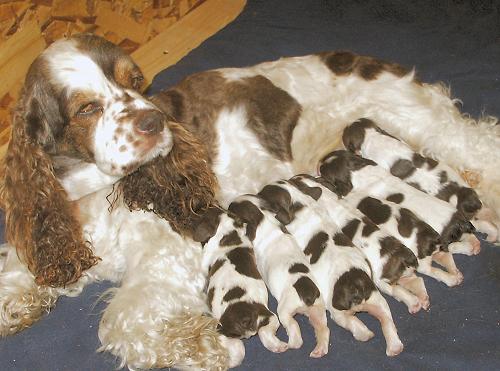
Puppies are born right around 63 days after the first mating. Most of our litters have arrived in the evening or overnight hours, rather than during the daytime. You will probably be up all night to help out, so you're not going to want to go to work the next day. Use your calendar to figure out the due date, and tell your boss right now that you probably will be missing a day of work on that day and/or the next. You should also warn your vet's office... and find out how to get their help if problems develop overnight or on a weekend.
In the weeks before birth, the mother dog's body expands out to the sides quite a bit. But in the last few days before birth, gravity kicks in and you will notice an unmistakable sag of the belly... the more pups, the greater the sag. If there are lots of pups, the belly may practically drag on the ground.
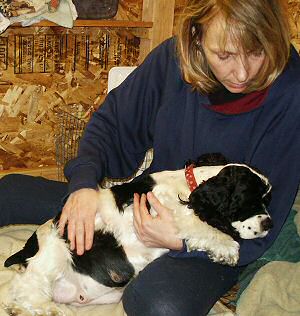 You will probably see a behavior change in the mother dog before the delivery. If
there's nothing you can do to convince her to eat something... that's a
real good sign! It usually means you'll have puppies later that day or the
next.
You will probably see a behavior change in the mother dog before the delivery. If
there's nothing you can do to convince her to eat something... that's a
real good sign! It usually means you'll have puppies later that day or the
next.
If you keep a real close eye on her, and you know her normal behavior well, there are also some signs that will warn you when it's a matter of hours to go... and time to move her to the birthing area. What you will probably notice is that the dog will act nervous or agitated. She may stay unusually close to you... probably due to being confused by what she is feeling. She might refuse to eat anything. She might paw at things as if she is trying to make a nest.
Ladies who have given birth to a human baby will understand that the sensation of having a baby about to come out is very similar to the sensation of needing to have a bowel movement. I know Mrs. Zim was fooled by it, and claimed the need to use the toilet just before delivering our first human child. The point is that in the days just before her due date, NEVER let your pregnant dog outside to go potty by herself! She may very well think she needs to poop when in fact there is a puppy about to be born! You definitely don't want the first one dropping out on your lawn! If it's close to 63 days after mating and you take her outside and she acts like she's trying to poop, but nothing will come out... she doesn't have to poop, she's in labor! Get her in to the place you want her to have her puppies.
When you see some signs that indicate birth may be coming soon, get someone to be with you. Unless you are experienced at delivering puppies, you're going to want an assistant. Tell your spouse you'll need their help for the next few hours, or get your oldest child to help, or call a neighbor. Don't try to do this alone unless you've been through this before! But don't have a whole bunch of people around, or anyone who can't remain CALM in a crisis!
You may have read that if you take your dog's temperature frequently, you will notice a sudden drop in body temperature when delivery is imminent. Our personal experience has been that this technique can not be relied on. Sometimes there has been a temperature drop before the birth of one of our litters, but more often than not we have just seen wildly fluctuating temperatures that don't really tell us much. Our advice is: don't bother taking your dog's temperature. Watch the dog's behavior instead. She'll act strangely just before giving birth. She may hide in a dark place, or start digging in her bedding, or get very clingy with you. If it's close to 63 days after mating and you find yourself saying "she is acting SO WEIRD today!" she's probably within hours of delivering puppies.
Regarding the birthing area... make sure you have chosen a quiet, protected, and well heated place for her to have her puppies. We like to recommend a small bathroom as a great place to deliver puppies. Because the room is small, and the door can be closed, it is a safe, quiet place... and it can be heated easily. Bring in a small portable heater and keep the room VERY warm once the first puppy is delivered. Don't use a heating pad... it's too easy to burn or overheat the pups. What you want to do is heat the air in the room. It needs to be very warm in there during the first few days, because the pups are born without much fur. We use a DeLonghi oil-filled radiator heater to heat our puppy room. Amazon.com sells a nice one at a reasonable price. They're heavy... so the shipping usually kills you when you buy one over the Internet... but if you order direct from Amazon.com you can take advantage of their free super-saver shipping offer. Buy one by clicking on the following advertisement, and they send me a small commission for the referral. Thanks!
If you let a newborn pup get too cold, things can go very badly. We usually keep the air in our puppy birthing room heated to around 80 degrees the first few days. Because of this, it's a good idea to give the mother dog a fairly short hair cut a week or two before her due date... so she will be comfortable in the warm room.
Monitoring the temperature in the room is important, so the pups do not get chilled. We use a digital thermometer so we know exactly what the air temperature in the room is. As you know, hot air rises, and floors can be quite cold... so it's important to not only know the temperature up at human level, but also the temperature down at puppy level. We use a wireless indoor/outdoor digital thermometer, and place the "outdoor" probe/transmitter down at floor level so we can get an accurate reading of what the temperature is down there. Here's a link to a good indoor/outdoor thermometer at Amazon.com Again, if you purchase one using this link, Amazon will send a small commission our way. Thanks!
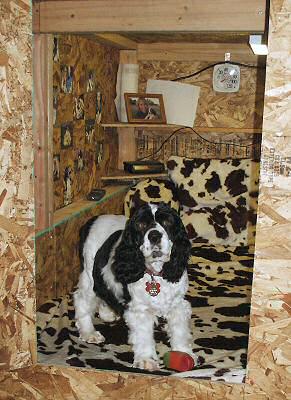 You will need some kind of box or enclosure to keep the puppies from crawling
away, but something that will still allow the mother dog to get in and out. Some
people use a large cardboard box, others use a small plastic kiddie swimming
pool... or you can make something more elaborate out of wood. Line the bottom
with old blankets and towels so that it is warm for the puppies, yet easy to
clean up.
You will need some kind of box or enclosure to keep the puppies from crawling
away, but something that will still allow the mother dog to get in and out. Some
people use a large cardboard box, others use a small plastic kiddie swimming
pool... or you can make something more elaborate out of wood. Line the bottom
with old blankets and towels so that it is warm for the puppies, yet easy to
clean up.
On the left, you can see a home-built puppy birthing box we used to use a few years ago. It was fully enclosed, with a door that could be shut in order to keep the heat in, and it was big enough for us to crawl in and help out. By using a heated enclosure like this and placing it in our garage, we didn't have to tie up a bathroom for puppies. In 2003, I built something a lot more elaborate! Click here for a tour of our Puppy Palace.
As long as you have a very warm room available for the delivery, though, you don't need to come up with a birthing box anywhere near this elaborate. A simple open-top box with sides low enough that the mother dog can jump over will work just fine.
If this is her first litter of puppies, she will be very confused about everything that starts happening during the delivery process. She may freak out a little! She may get really frantic about finding a place where she wants to deliver the pups. It may not be where you want her to deliver them! Starting a week or two prior to the arrival of the pups, have her sleep in the place where you want her to deliver the pups. This will help her feel very comfortable there. Once those puppies start arriving, close doors or put up gates to confine her to the area you have chosen for the delivery. That way she will see that the only available comfortable spot to have the pups is the spot you've chosen.
During delivery, let the mother dog do all the pushing... don't try to help
pull a puppy out. But once the puppy is out, that's where you need to jump in to
action. The puppy will probably come out fully enclosed within a birth
sac, and with an umbilical cord attached. You might be
tempted to think that the first order of business is to cut that umbilical cord,
but actually your first concern is to get that pup out of the birth sac and to
get the pup breathing.
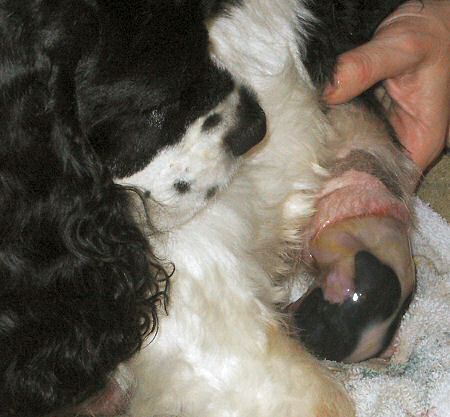
A puppy half way out of the birth canal,
still fully enclosed in a birth sac.
The mother dog, our girl, Abby, has turned her head to watch the action.
There are two ways you can get the puppy out of the birth sac. You could let the mother dog lick the sac off of the pup, or you can just use one of your fingernails to tear open the sac. A picture is worth a thousand words, and a video is even better... so let's watch how it is done in this video of two of our puppies being born. (To start the video playing, click on the triangle of the following picture)
At the :55 mark in the video clip, notice how Mrs. Zim quickly uses her fingernail to rupture the birth sac, and then uses a towel to both clean off the pup and to stimulate it to breathe. Great technique... you can tell she has done this many times before and knows exactly what she is doing!
Once the puppy is out of the sac, remember it's still not time to cut the umbilical cord yet. The first order of business is to get the pup breathing. The easiest way is to cradle the pup in your hand, being gentle not to tear the umbilical cord, and to place the pup where the mother dog can lick it. The licking will stimulate the puppy to breathe. An alternate technique, which you saw in the previous video, is to vigorously rub the puppy with a towel to stimulate it.
Only after the puppy seems to be breathing and moving around a bit, is it time to deal with the umbilical cord. Take a piece of dental floss about 6-8 inches long and tie off the umbilical cord close to the body of the puppy. Then take a clean pair of scissors and cut the umbilical cord and any excess dental floss. Once you have the puppy breathing and umbilical cord tied and detached, place the pup where the mother dog can lick it some more.
A word of caution: be very careful during all of this not to accidentally tear the umbilical cord off of the puppy. When all is said and done, you should have a piece of umbilical cord about an inch long hanging off the puppy... tied off with dental floss. The umbilical cord will dry up and fall off naturally over the next several days. If you accidentally pull it off the pup's tummy, or tear it, this would be a bad thing. The pup could develop an umbilical hernia... or worse... could bleed to death.
Between letting the mother dog lick the pup and you vigorously rubbing the pup with a towel, you should be able to get each pup breathing and moving around OK.
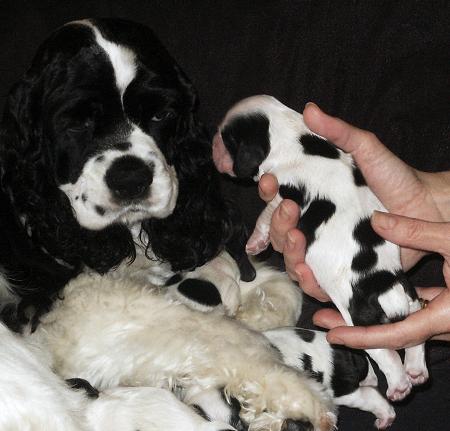 However, you may run in to a pup that has swallowed some fluid and has
difficulty breathing because he is choking on fluid in the windpipe. If you hear
coughing or choking, this is probably what is going on. Try to clear the fluid out of the airway by using a
bulb syringe to suck fluid out of the nasal cavity and out of the throat.
However, you may run in to a pup that has swallowed some fluid and has
difficulty breathing because he is choking on fluid in the windpipe. If you hear
coughing or choking, this is probably what is going on. Try to clear the fluid out of the airway by using a
bulb syringe to suck fluid out of the nasal cavity and out of the throat.
If the pup still seems to be having difficulty breathing after you suction the fluid out of his nose and throat, it's time to try a more aggressive maneuver. Please note that you never use this maneuver as your first line of defense... this is a last-ditch effort to save a pup. The maneuver I'm referring to is to quickly swing the pup (with his nose facing AWAY from you) in an arc so that the force of the swinging tends to move the fluid out of his throat and out his mouth. Can you visualize this? It's much like if you were trying to empty a bottle by swinging it around in a circle with the open end of the bottle facing the outside of the circle. Do this a couple of times and see if this has helped clear the fluid out of the puppy's windpipe. If not for that simple technique which we learned on the Animal Planet cable channel, Riley, a red & white puppy in our 2003 litter, would never have survived.
There's actually a video that I found on YouTube which perfectly demonstrates what I'm talking about. In the video, the situation is a little different than the one I mentioned... the pup in the video isn't coughing or choking, he isn't breathing at all. He is basically stillborn. The woman delivering the puppies knows exactly what to do to revive the pup, though. Notice that she doesn't do the swing-the-pup-in-an-arc thing right away. It is a last-ditch effort to be used only when all else has failed. She tries a less aggressive resuscitation technique first... she vigorously rubs the pup with a towel. Only when that doesn't work does she go with the last-ditch method of swinging the pup to clear the airway. It happens at 1:50 in to the video.
Just to be clear... that's not my video, and that's not us in the video! It's just a video I found on the Internet which perfectly demonstrates the last-ditch method of reviving a pup with fluid in his airway.
After each pup is born, the mother will expel a very gross looking mess of bloody tissue... "the afterbirth". It is very important that you let the mother dog lick the afterbirth and even eat some or all of the afterbirth of the first few puppies. This is extremely nourishing stuff that will give the mother dog the energy she needs to get through the first day. Seeing the afterbirth and encouraging her to eat some of it is going to gross you out, but you'll just have to get over it!
Remember, sometimes puppies will come 10 minutes apart, but sometimes it can be well over an hour between them or even many hours between them. Don't let your guard down until it's been more than several hours since the last one AND she seems to be relaxing. If it's been a long time since the last one, and she still seems to be laboring and trying to push out another puppy, she may very well have one stuck in the birth canal. This is an emergency situation, and you should call your vet or local emergency animal hospital. If you're pretty sure there are more puppies to come, but your dog doesn't seem terribly stressed or act like she's in pain... there's no need to get the vet involved, just hang in there. When the last puppy has been delivered, you usually will see the mother dog act much more relaxed than she has been during the last several hours. I've heard from people who have gone five hours or more in between puppies, so be really careful to continue keeping an eye on your dog and her new puppies even after you're pretty confident she has delivered the last pup. The way my wife and I handle it is we both are there during the labor and delivery... and once we're pretty sure the last pup has arrived, one of us goes to bed and the other stays up and watches over the mom and the new puppies. For the next several days, we take shifts so that we're sure the puppies are constantly being monitored. That way, if one more puppy arrives... we're still in position to assist. It's also very common for a mother dog to sit on top of a puppy... and if someone is there to catch it, you can prevent a helpless young puppy from getting smothered to death.
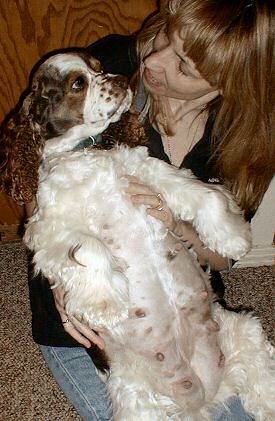 Puppies have a general instinct to find a nipple, and the mother dog has a
general instinct to allow the puppies to nurse... but there is a definite
learning curve for all involved. Help them out by gently guiding each puppy to a
nipple and if they can't seem to figure it out on their own you can gently grab
the puppy's head and place the mouth right on a nipple. Much like nursing a
human baby the very first time, it doesn't just happen perfectly from the first
attempt, but with a little trial and error the puppies will figure it out.
Puppies have a general instinct to find a nipple, and the mother dog has a
general instinct to allow the puppies to nurse... but there is a definite
learning curve for all involved. Help them out by gently guiding each puppy to a
nipple and if they can't seem to figure it out on their own you can gently grab
the puppy's head and place the mouth right on a nipple. Much like nursing a
human baby the very first time, it doesn't just happen perfectly from the first
attempt, but with a little trial and error the puppies will figure it out.
You can make it easier for the newborn puppies to find nipples if you completely shave the mother's tummy around all the nipples about a week before her due date. The picture on the right shows what it will look like... you can imagine how much easier it will be for the puppies to nurse this way.
Just remember that it's not going to kill the puppy if he doesn't nurse right away. There is plenty of time. If things get a little crazy during the birth process, just put any previously born pups in a soft warm place until things calm down and they can nurse. If they have to go an hour or longer without nursing, it's not a problem.
Try to avoid the temptation to bottle feed a puppy with replacement milk formula. Most puppies will be able to nurse just fine. Anybody having trouble nursing should be given one-on-one time with mom so that they do not have to compete against all the siblings for nipple time.
 Buy yourself a nice digital scale that can measure pounds and ounces. Take
daily measurements of each pup's weight, and keep a chart so you can keep an eye
on the progress of each pup. You will see that each pup will typically gain about
a half ounce per day in the first few days... about an
ounce each day after the first few days... and once the mom and the pups
really get "in the groove" those pups may gain as much as two ounces a day. Any pup that is not gaining as much weight as the rest of
the pack should be given special time alone with mom to catch up on feeding
without any competition from the siblings.
Buy yourself a nice digital scale that can measure pounds and ounces. Take
daily measurements of each pup's weight, and keep a chart so you can keep an eye
on the progress of each pup. You will see that each pup will typically gain about
a half ounce per day in the first few days... about an
ounce each day after the first few days... and once the mom and the pups
really get "in the groove" those pups may gain as much as two ounces a day. Any pup that is not gaining as much weight as the rest of
the pack should be given special time alone with mom to catch up on feeding
without any competition from the siblings.
If you'd like to compare the weights of your puppies to one of my litters, to see if yours are on the right growth track, click here. What you'll see is our handwritten notes from one of our litters of puppies, showing the weights of each pup from the day of birth all the way up until the day they went to their new homes. Please note that the weights listed for the first few days are in ounces, and after that they are in pounds and ounces. For example, "1:4 3/4" means a weight of 1 pound and 4.75 ounces.
When the puppies are very young, like the one pictured above/left, they will sit right up on top of the scale. Later, when they learn to move around better, they wiggle so much they won't stay on the scale. My famous trick to restrain a puppy on the scale is to use a bread pan from the kitchen.
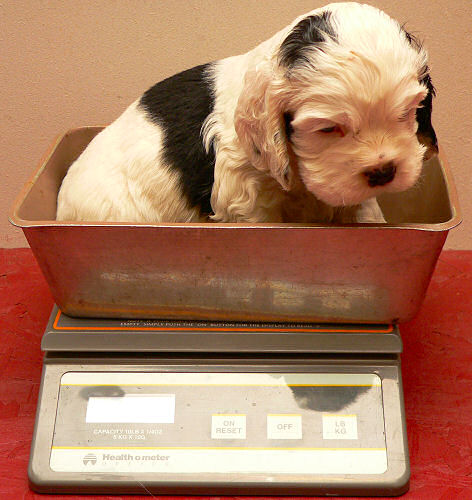
Here's a link to a really nice digital scale at Amazon.com that is perfect for weighing puppies. If you purchase this scale through the link on this page, Amazon will send a small commission our way. Thanks! Be sure to choose free super-saver shipping at checkout.
The first couple of days are a very dangerous time for the puppies. It's very common to have as many as several puppies die in the first few days. The best thing you can do to improve the odds is to have someone watching the pups twenty four hours a day for at least the first 2 or 3 days. If you leave them alone during this time, it would not be uncommon for the mother dog to accidentally lie on and smother to death a puppy or two. By having someone there you also can help to make sure that all the puppies get an equal opportunity to nurse. Otherwise you will find that the larger stronger pups will tend to hog all the nipples and the smaller weaker pups won't get much of a chance.
If you do happen to have a puppy pass away, keep in mind that it might just be the best thing in the long run. We've known puppies who have been saved by heroic efforts, only to grow up with serious health problems as adults. Weeding out the sick and weak is nature's way. A tip regarding dead puppies: don't just take them away. The mother has a rough idea in her head of how many puppies she has. If all of a sudden there is a puppy or two missing, she may start very frantically looking for the missing pups. I know this is gross... but let the mother dog spend some time with the bodies of any dead puppies. She needs to see for herself what happened, so she doesn't waste a bunch of energy trying to "find" puppies that you've buried.
The first week is also a very dangerous time for the mother. With all those puppies placing a huge demand on her system, sometimes there isn't much nutrition left for mom. It's absolutely critical that she get extra calcium, protein, and water to help support the pups and herself. If she doesn't get the extra nutrition she needs -- and calcium is the most important -- she can get eclampsia... and that can be life threatening. The larger the litter, the more likely this is to be a problem... because large litters put a huge drain on the mother's resources.
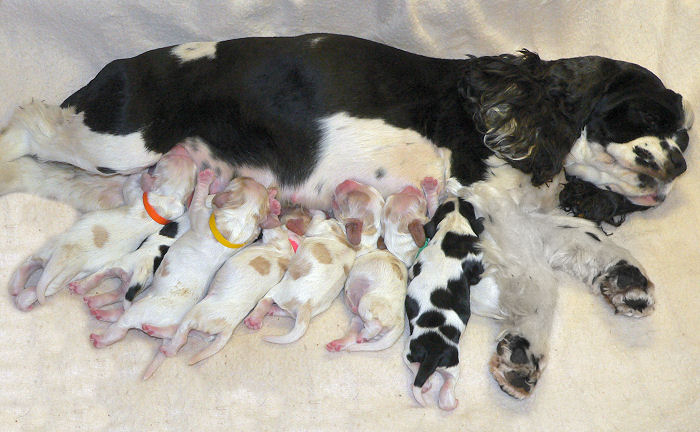
One of our dogs that had a litter of 8 puppies scared the heck out of us when she got eclampsia. She was so devoted to her puppies that she basically wouldn't leave the litter box. We couldn't get her to eat! After a few days we could see her health going downhill... the most noticeable thing was she actually started to shake. Realizing something was going horribly wrong, we rushed her to our vet... who had to give her fluids and vitamins intravenously for the better part of the day. Because the pups had to go, too... the bill for hospitalizing mom and a whole litter of puppies got a little nasty! (And people wonder why puppies cost so much!) The moral of the story is: feed your pregnant and nursing female a calcium supplement for pets... and make sure she drinks plenty of fluids. If you can't get her to drink a lot of water, buy some goat's milk... she'll love that. Never use cow's milk for a dog, because they can't digest the lactic acid and they get a horribly upset tummy... which can result in vomiting, diarrhea, and the worst possible thing when you're locked in a small space with your dog: gas!
One other tip for people with a new litter of Cocker Spaniel puppies: the day the puppies arrive, call your vet's office and make an appointment to have the tails docked. This should be done when the puppies are five days old.
When we have a litter on the way, we make sure we have:
A safe place for the pups to be born.
A heater to keep that place warm.
Lots of clean old towels and blankets.
Dental floss.
Scissors.
A bulb syringe.
A camera.
One person "in charge" and one assistant.
A notebook and pen to record details of the birth... a description of each pup,
the order they were born in, and the birth weight using a postal scale.
(Typical birth weight of a Cocker puppy is about 8 ounces.)
Wondering what coat colors your Cocker Spaniel puppies will have? Curious about what happens in all the various scenarios of breeding various coat colors to each other? Check out the Cocker coat color inheritance chart.
Want some ideas on how to be a responsible breeder? Curious about what sets the good breeders apart from the bad ones? Read our tips on how to be a responsible breeder.
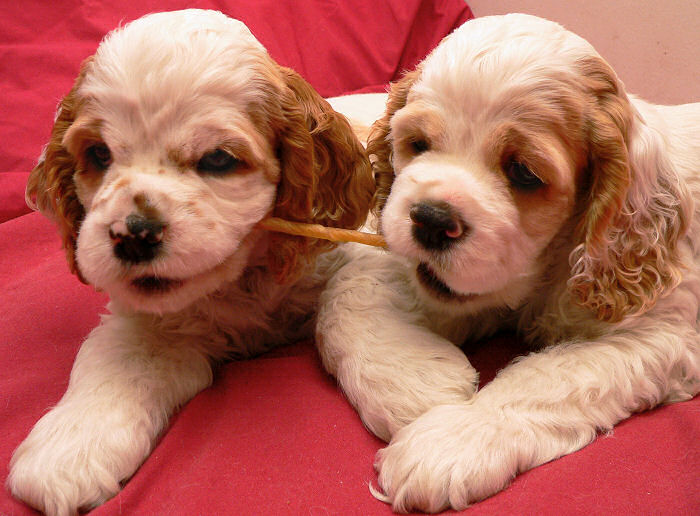
Something that a lot of new breeders don't understand is the importance of keeping the litter together for the first 8 weeks. You'll notice that mom will be feeding the puppies a lot less often once they start getting their teeth at around four weeks of age. She'll try to get away from the puppies... and you'll notice that if given a choice, she'll not want to spend a lot of time with them. By five or six weeks, you may even be convinced that they are totally weaned and don't need her anymore. Whatever you do, don't send the puppies to their new homes yet!
The first reason is that you may be wrong about mom not feeding them anymore. Because there's a human bed inside of our Puppy Palace, I've spent many nights with our puppies. It was a real surprise to find that long after mom had stopped feeding them during the days, she was still feeding them at night.
The other more important reason to keep puppies until they're 8 weeks of age is the social process that occurs between a puppy, his siblings, and his mom. During weeks 5 - 8, when some breeders have already placed puppies in new homes, a puppy should be learning a lot of extremely important things from the other dogs. Things like not to bite too hard, and how to get along with other dogs... for example. There's also the security of being with their siblings... it's just way too intimidating for a six week old pup to be alone with a world full of strangers. Don't sell off your puppies until they're at least 8 weeks of age, even if you think they're weaned long before that. Keep all the puppies together, and let mom spend as much time with the pups as she wants. Provide her with some kind of thing (like a bench) that she can jump up on to get away from the pups when they start tugging on her ears and biting her legs.
What else have I learned as a breeder of Cocker puppies? Read my tips on buying a Cocker Spaniel puppy, my tips on raising a Cocker puppy, and my tips on potty training a Cocker puppy. You'll also find some useful information in my list of frequently asked questions.
There is a LOT more to this web site than just this page!
Please explore the rest of the site by viewing our table of contents,
or by clicking on one of the quick links below.
All About Our Cockers Meet Jim Zim Contact Jim Zim